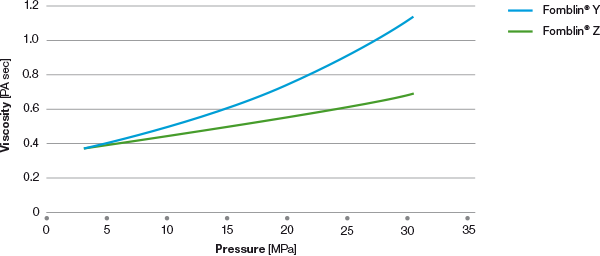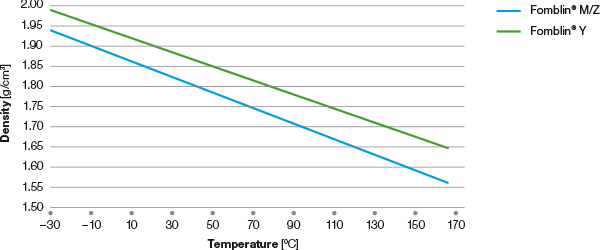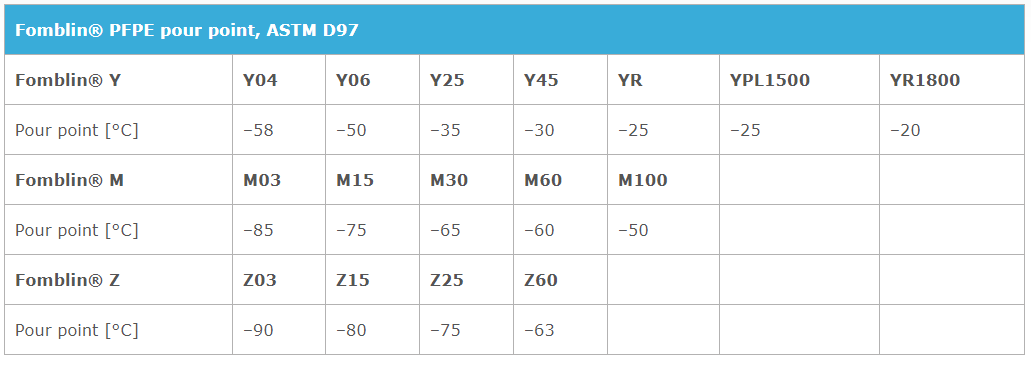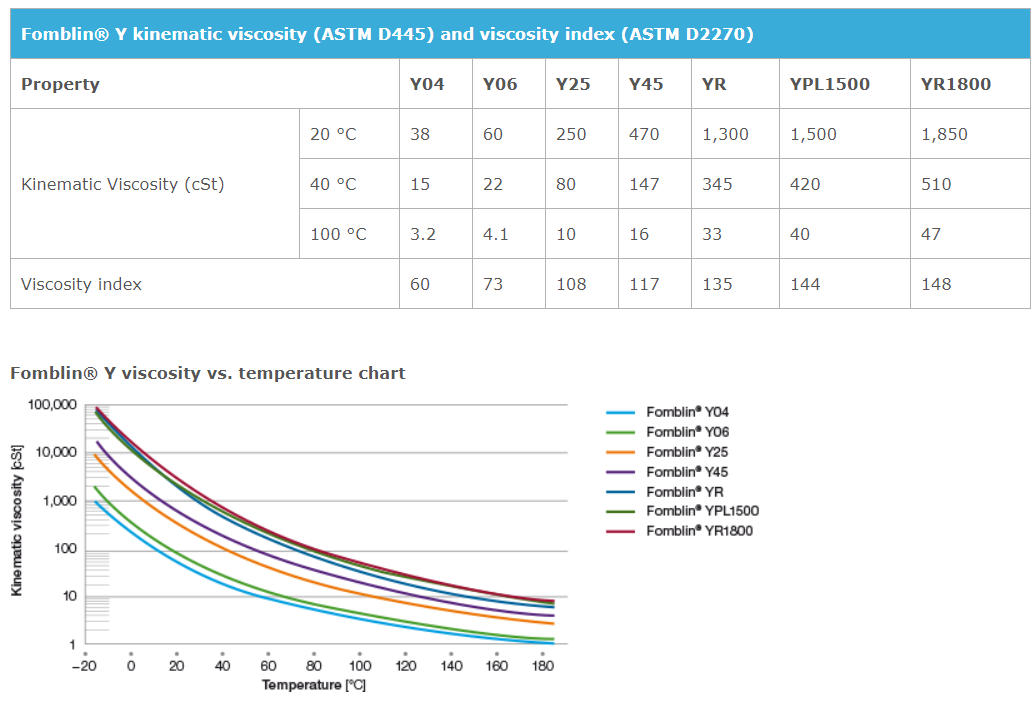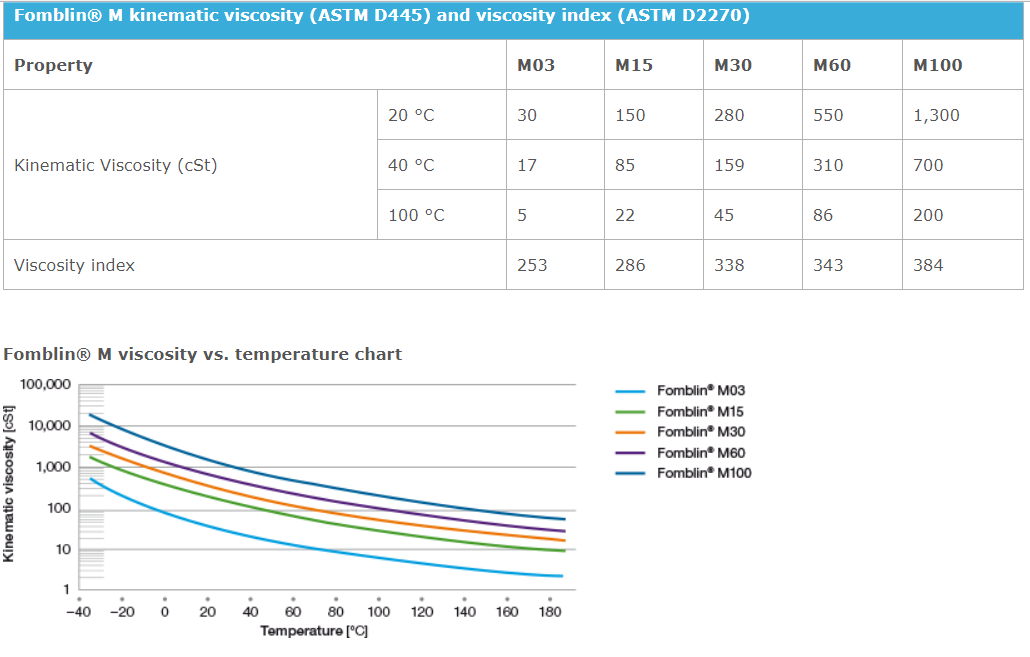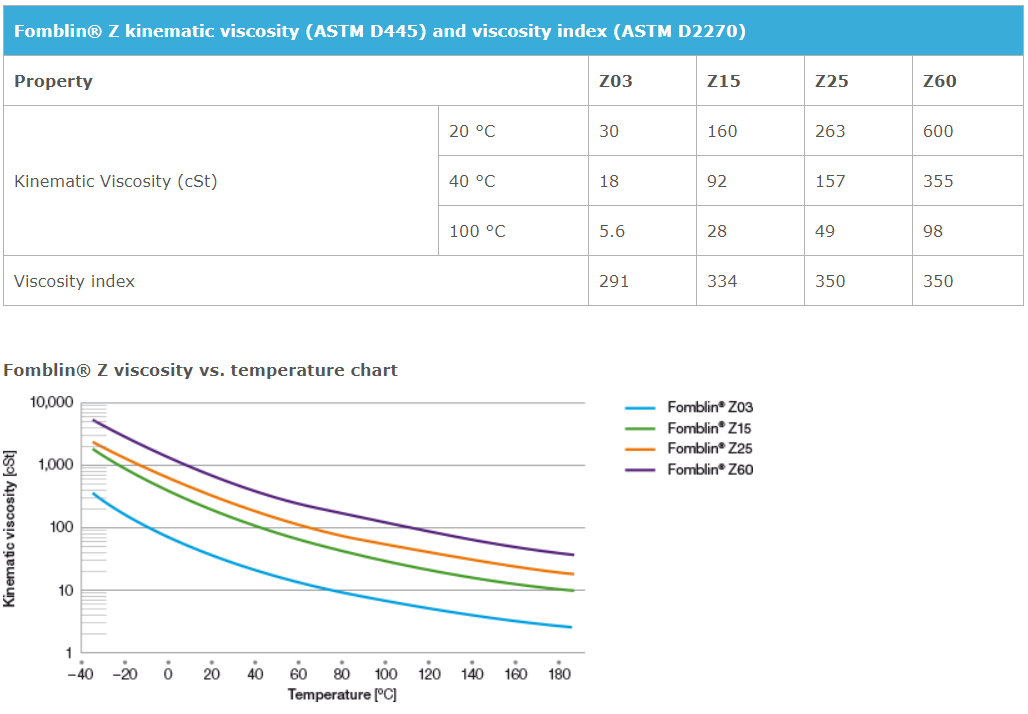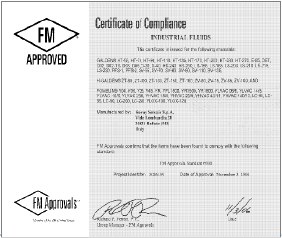The trade name Fomblin® PFPE identifies a family of synthetic lubricants entirely composed of carbon, oxygen and fluorine, belonging to the class of perfluoropolyethers. They are produced by Syensqo Specialty Polymers through a proprietary and versatile technology: the low-temperature reaction of oxygen with perfluorinated olefins activated by UV light. This platform allows to obtain different structures in a wide range of molecular weights. Key properties such as viscosity and vapor pressure can therefore be tailored to the target application. They are clear, colorless and odorless oils that remain liquid in a very wide range of temperatures, spanning –100 °C (-148°F) up to 290°C (554°F). Fomblin® PFPEs are thermally stable, chemically inert, and compatible with metals, hydrogenated polymers, oxygen and aggressive gases even at very high temperatures.
They are not flammable and non-toxic. They have low vapor pressure, good dielectric properties, low refractive index and low surface tension.
When critical applications have to be addressed where aggressive chemical environment, high temperatures or wide working-temperature ranges are involved they represent the lubricants of choice.
Fomblin® PFPE oils can be thickened with polytetrafluoroethylene (PTFE) to give white and homogeneous lubricating greases of different consistency.
Fomblin® Y and Fomblin® M/Z perfluoropolyether fluids are produced starting from different monomers, hexafluoropropene and tetrafluoroethylene respectively, and for this reason they have different chemical structures:
Fomblin® Y
Fomblin® M/Z
Fomblin® M/Z oils have excellent viscosity indexes, very low evaporative losses, excellent low-temperatures properties and good thermal stability.
Fomblin® Y oils are characterized by excellent thermal stability, good viscosity index, good low-temperature properties and low evaporative losses.
The following combination of properties and characteristics makes for sure Fomblin® PFPE the right product for your application:
- Excellent chemical and solvent resistance
- Excellent thermal resistance
- Excellent electrical resistance
- Non-reactive with metal, plastic, elastomers and rubber
- Inert to liquid and gaseous oxygen
- Excellent radiation hardness
- From good to outstanding (> 300) viscosity index depending on the grade
- Non-flammable
- Extremely wide operating temperature
- From low to extremely low evaporation loss depending on the grade
- Excellent properties at low temperatures, starting torque for example, depending on the grade
- Excellent water washout properties
- Good low and high temperature wear properties
- Easily formulated into greases
- Environmentally safe
- Zero ozone depletion potential
- No volatile organic chemicals
- Non-toxic
Fomblin® PFPE lubricants and their formulations into greases are successfully employed in all the industries in need of high performance lubrication like chemical, electronic, military, nuclear and data processing.
Examples of uses of Fomblin® PFPE lubricants include:
- Tenter frames in the textile industry
- Deep space rocket nozzle lubrication
- Missile catapult system lubrication
- Sintered metal bearings requiring exceptional operating life
- Anti-lock braking systems
- Oxygen and chlorine valves and pumping systems
- Sealing fluids for vacuum pumps
- Gold contact surface lubrication
- Nuclear industry lubricants
- Instrument lubricants
- Lifetime sealed, maintenance-free bearings
- Lubricants for gasoline tank floats
- Bearings exposed to high temperatures, moisture and aggressive chemicals
The complete spectrum of vacuum needs, low/medium/high, is covered by a selection of Fomblin® PFPE oils’ grades. More in detail, Fomblin® Y LVAC are grades designed for vacuum pumps as sealing and working fluids in the presence of aggressive gases. Fomblin® HVAC140/13 is the product of choice for high vacuum applications since it combines narrow molecular weight distribution and controlled viscosity with extremely low vapor pressure.
Fomblin® PFPE products have not been approved for medical applications involving permanent or temporary implantation in the human body or permanent or temporary contact with internal body fluids or tissues.
The performance of Fomblin® PFPE lubricants is unaffected by pressure. Their viscosity increases under pressure and they compress slightly. The viscosity of Fomblin® Y shows a more pronounced dependence on pressure compared to Fomblin® Z. This is due to the different chemical structures and in particular to the presence of the bulky – CF3 pendant group in the chain of Fomblin® Y. The figure below shows a variation of the viscosity with pressure, measured at 30 °C in the range 3 – 10 MPa for a Fomblin® Y and a Fomblin® Z having comparable viscosity of 250 cSt at 20 °C (68°F).
Fomblin® PFPE viscosity vs. pressure chart
Fomblin® PFPE oils can be used from -90°C (-130°F) up to 290°C (554°F) depending on the grade. Fomblin® PFPE doesn’t burn or carbonize to form tarry deposits thus avoiding a typical cause of equipment failure at very high temperatures. The only modification you may observe is a light evaporation of the oil. Our wide selection of products allows minimizing this effect by matching application requirements and oil profile. Fomblin® PFPE oils are designed to provide lubrication also when heating and vacuum are combined, conditions under which conventional oils would be vaporized leading to contact metal counterfaces seizure.
The density of Fomblin® PFPE oils is approximately twice that of standard lubricants; it is comprised between 1.8 and 1.9 kg/liter depending on the grade. This has to be taken into account when filling bearings by weight. The typical dependence of density on temperature for two grades of Fomblin® Y and Fomblin® M having similar viscosities at 20°C (68°F) is shown in the figure below.
Fomblin® PFPE density vs. temperature chart, ASTM D4052
Fomblin® PFPE oils are able to flow down to extremely low temperatures, having pour points as low as -90°C (-130°F) in the case of Fomblin® M/Z. Typical values are shown in the table below.
Fomblin® PFPE lubricants cover a wide viscosity range and are characterized by very good Viscosity Index (VI), varying from 60 to 350 depending on the grade. High VI means slow change of viscosity with temperature and, consequently, a wider operating temperature range. The effective viscosity of a lubricant in a bearing may be different from the quoted viscosity measured by a standard test method. This difference depends on the actual shear rate in the bearing that can be higher compared to conditions typical of test methods. Fomblin® PFPE oils display Newtonian behavior, e.g. their viscosity remains constant up to shear rate as high as 106 s–1.
Typical values are reported in tables 2 – 4 for Fomblin® Y, M and Z. Figures 3 – 5 show viscosity temperature relationship.
No. Fomblin® PFPE is not flammable. It doesn’t have a flash, fire or autoignition point. Fomblin® PFPE fluids are Factory Mutual Underwriters Approved.
Fomblin® PFPE has a good resistance to radiations. It can be used for the lubrication of gears in UF6 ultracentrifuges.
The structure of Fomblin® PFPE, thanks to the presence of fluorine, is highly stable and inert. For this reason Fomblin® PFPE does not oxidize unlike hydrocarbons and other synthetic lubricants.
No. Fomblin® PFPE are very safe fluids:
- No flash or fire point
- No explosion hazard
- No toxicity
- No autoignition point
- Thermal, oxidative and chemical stability
- Shelf life over 20 years
Fomblin® PFPE fluids are chemically inert and thermally stable up to 290°C (554°F). Some of the decomposition products are potentially dangerous. Fomblin® PFPE fluids do not react with chemicals and refrigerants and do not get oxidized.
Fomblin® PFPE fluids are dielectric materials. They have low dielectric constant (typical value 2) and high volume resistivity (typical value 1·1015 ohm·cm).
Fomblin® PFPE oils are compatible with all types of polymers, plastomers and elastomers. Nitrile, butyl, polyfluorosiloxane, EPDM rubber don’t show any sign of swelling or mechanical or physical alteration after prolonged contact with Fomblin® PFPE. Melamine, phenolic, polyoxymethylene, and polyolefin resins can be used in combination with Fomblin® PFPE up to their limit of operational range. Fomblin® PFPE lubricants are compatible with glass, ceramics and metals. They can be used with water, oils vapor and in general with all organic compounds and not-highly-fluorinated solvents without being removed, dissolved or modified in any way. Compatibility data of Fomblin® PFPE lubricants are shown in the tables below. Specific compatibility tests according to standard methods can be performed upon request.
| Fomblin® PFPE compatibility with chemical agents | |||
| Material | Temperature | Test Condition | Result |
| Hydrogen halides | |||
| HF, HCl, HBr | 200 °C (392°F) | 1 l/h; 24 h | Unchanged |
| Halogens | |||
| Cl2, Br2, F2 | 200 °C (392°F) | 1 l/h; 24 h | Unchanged |
| Non-metal halides | |||
| BF3, BCl3, SbCl3, UF6 | 80 °C (176°F) | 5 % (w/w); 24 h | Unchanged |
| PBr3, PCl5 | 150 °C (302°F) | 5 % (w/w); 24 h | Unchanged |
| SiCl4, SiHCl3 | 150 °C (302°F) | 1 l/h; 24 h | Unchanged |
| Sulphur anhydrides | |||
| SO2, SO3 | 200 °C (392°F) | 1 l/h; 24 h | Unchanged |
| Mineral acids | |||
| Conc. H2SO4, HNO3, H3PO4 | 70 °C (158°F) | 50 % (w/w); 24 h | Unchanged |
| Alkalis | |||
| KOH, NaOH, Na2CO3 | 200 °C (392°F) | 20 % (w/w) | Unchanged |
| Aqueous oxidizers | |||
| KMnO4 (6 % w/w) | 70 °C (158°F) | 50 % (w/w); 24 h | Unchanged |
| K2Cr2O7 (10 % w/w) | 70 °C (158°F) | 50 % (w/w); 24 h | Unchanged |
| Organic solvents | |||
| Hydrocarbons | 20 °C (68°F) | 50 % (w/w) | Unchanged |
| Alcohols | 20 °C (68°F) | 50 % (w/w) | Unchanged |
| Ethers | 20 °C (68°F) | 50 % (w/w) | Unchanged |
| Esters | 20 °C (68°F) | 50 % (w/w) | Unchanged |
| Amides | 20 °C (68°F) | 50 % (w/w) | Unchanged |
| Ketones | 20 °C (68°F) | 50 % (w/w) | Unchanged |
| Acids | 20 °C (68°F) | 50 % (w/w) | Unchanged |
Internal method; unchanged means no change in acid number and viscosity change ± 2 %
| Fomblin® PFPE compatibility with vulcanized rubbers | ||||
| Volume Increase [%] | Tensile Strength Retained [%] | Elongation Retained [%] | Hardness Change Points | |
| Fomblin® Y | ||||
| Natural rubber | 2 | 106 | 125 | –3 |
| 1,4-cis-polybutadiene | 8 | 83 | 107 | –3.5 |
| Styrene butadiene rubber | 0.8 | 104 | 138 | –2 |
| Polychloroporene | –0.5 | 115 | 118 | 0 |
| Butadiene-acrylonitrile rubber | –0.3 | 95 | 103 | +4.5 |
| Ethene propylenediene terpolymer | –0.3 | 114 | 120 | +0.5 |
| Fomblin® M | ||||
| Natural rubber | 0.1 | 91 | 90 | –3 |
| 1,4-cis-polybutadiene | 0.1 | 71 | 70 | –1 |
| Styrene butadiene rubber | 0.1 | 74 | 76 | +2 |
| Polychloroporene | 0.4 | 97 | 103 | –2 |
| Butadiene-acrylonitrile | 0.1 | 101 | 94 | –2 |
| Ethene propylene-diene | 0.3 | 108 | 104 | –3 |
ASTM D471, 70 °C, 166 hrs, on grades having viscosity of 250 cSt at 20 °C
| Fomblin® PFPE compatibility with plastomers | |
| Plastomer | Results |
| Polyphenylene oxide | Unchanged |
| Polyethylene-terephthalate | Unchanged |
| Polybutylene-terephtalate | Unchanged |
| Polystyrene | Unchanged |
| Polyethylene low density | Unchanged |
| Polyethylene high density | Unchanged |
| Polypropylene | Unchanged |
| Acrylonitrile-styrene-copolymer | Unchanged |
| Polymethylmethacrylate | Unchanged |
| Acrylonitrile-butadiene-styrene-copolymer | Unchanged |
| Polyamides | Unchanged |
| Polyvinylchloride | Unchanged |
| Acetal copolymer | Unchanged |
| Polycarbonate | Unchanged |
Perfluoropolyethers are characterized by low anti-rust properties. Syensqo Specialty Polymers has developed a family of proprietary soluble anti-rust additives. These additives, Fomblin® DA305 and Fomblin® DA306/VAC, comes from the same technological platform as Fomblin® PFPE oils. They present functional groups that allow them to interact with the surfaces establishing durable bonds and consequently improving surface protection. Fomblin® DA305 is specially designed to work with Fomblin® PFPE based greases, while Fomblin® DA306/VAC has been designed for oils. The availability of additivated Fomblin® PFPE oils widens the range of applications for perfluorinated lubricants in fields requiring improved anti-rust properties.
Our technical service team is at your disposition to help you select the right Fomblin® PFPE product for your application. Don’t overlook basic details that can have a significant impact on the resulting lubricant’s performance. You should provide us with as much information as possible to help us identifying the lubricant best suited to your needs.
The key requirement for selecting the proper lubricant is the base oil viscosity. In order to select the appropriate viscosity, we need to gather information about your application, including:
- Operating speed (variable or fixed)
- Specific type of friction (e. g., sliding or rolling)
- Load and the environmental conditions
- Industry standards
If your equipment is lubricated for life, synthetic oils are recommended for their many benefits, including:
- Low / High temperature viscosity performance combined with decreased evaporative loss
- Reduced friction and reduced wear
- Improved efficiency and chemical stability
- Resistance to oil sludge problems and extended drain intervals
Fomblin® M03, M15, M30, M60, Fomblin® Y04, Y06, Y25, Y45, YR, YR1800, Y LVAC 25/6 are all approved with the intended use described below:
- H1: General, incidental contact
- H2: General, no contact
- HX-1: Ingredients for use in H1 lubricants, incidental contact
- HX-2: Ingredients for use in H2 lubricants, no contact
Fomblin® M30/RP is approved with the intended use described below:
- H1: General, incidental contact
- H2: General, no contact
Fomblin® PFPE lubricants are approved according to FM 6930 standard for flammability classification of industrial fluids. This standard states the flammability classification rating for industrial fluids intended for, but not limited to, lubricants, hydraulic power transmission, turbine governor control, transfer insulation and cooling.
Yes. Bundesanstalt fur Materialprüfung, Berlin (BAM) has approved the use of Fomblin® PFPE fluids in the presence of oxygen. Additionally, the National Aeronautics and Space Administration (NASA) and the Naval Ship Engineering Center of the US Navy have both approved the use of Fomblin® PFPE fluids in liquid oxygen applications. Fomblin® LC grades are special fluids for oxygen handling and lubrication of oxygen pumps and compressors. Fomblin® LOX are special fluids tailored for handling oxygen when a low vapor pressure is required. Different grades having different viscosity/temperature relationships are available. Temperature and pressure limits of oxygen with Fomblin® PFPE are available upon request.
Fomblin® VAC fluids have been specially developed in order to combine narrow molecular weight range and controlled viscosity with extremely low vapor pressure. Thus they provide superior performance in high vacuum applications, especially systems exposed to aggressive gases. Syensqo is able to provide these grades due to its leading-edge technology with a distillation step that enables us to design tailor-made products according to customer requirements.
| Fomblin® Y LVAC Grades | Fomblin® Y HVAC Grades | ||||
| Application | 06/6 | 14/6 | 16/6 | 25/6 | 140/13 |
| Rotary pumps: sealing & lubricant fluid | √ | √ | √ | ||
| Turbomolecular pumps: lubrication | √ | ||||
| Root pumps: lubrication | √ | ||||
| Diffusion pumps: working fluid | √ |
Fomblin® Y LVAC viscosity vs. temperature chart
Fomblin® Y LVAC vapor pressure vs. temperature chart
Rust Preventive formulation (LVAC RP) was studied to reduce or prevent rusting when huge amount of water vapors has to be pumped or when metal surfaces of the pump are exposed to moisture. An optimum concentration of additive in Fomblin® Y LVAC grades was studied to provide protection against rust and at the same time to guarantee the physical properties and the vacuum performance of the grade.
Anti-rust property evaluation
- Fog chamber (method ASTM B117)
- Conditions: temperature = 45 °C, humidity = 90 %
| Sample | Fluid | Fog Chamber Time | Corrosion Degree | Fog Chamber Time | Corrosion Degree |
| Cast iron | Y LVAC | 40 mins | 5 | 1 hour | > 5 |
| Low carbon steel | Y LVAC | 40 mins | 4 | 1 hour | 5 |
| Cast iron | Y LVAC RP | 24 hours | 0 | 96 hours | 1 – 2 |
| Low carbon steel | Y LVAC RP | 24 hours | 0 | 96 hours | 2 |
Rating
0 – No corrosion
1 – Not more than three small spots of corrosion
2 – Small areas of corrosion covering up to 1 % of the surface
3 – Small areas of corrosion covering from 1 % to 5 % of the surface
4 – Small areas of corrosion covering from 6 % to 10 % of the surface
5 – Small areas of corrosion covering more than 10 % of the surface
Fomblin® PFPE anti-rust additivated grades maintain the same viscosity and vapor pressure behavior than not additivated ones. As the following charts show:
Fomblin® Y LVAC RP – viscosity vs. temperature chart
Fomblin® Y LVAC RP – vapor pressure vs. temperature chart
Fomblin® Y LVAC 25/6 is NSF approved with the intended use described below:
- H1: General, incidental contact
- H2: General, no contact
- HX-1: Ingredients for use in H1 lubricants, incidental contact
- HX-2 Ingredients for use in H1 lubricants, no contact



